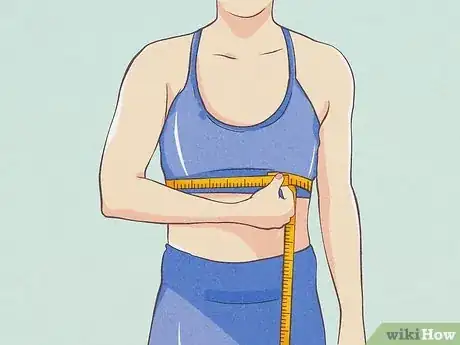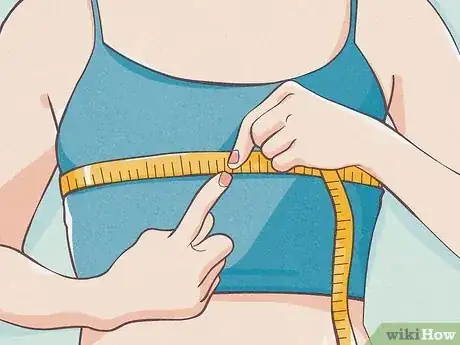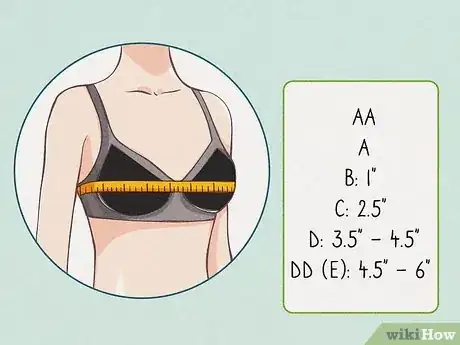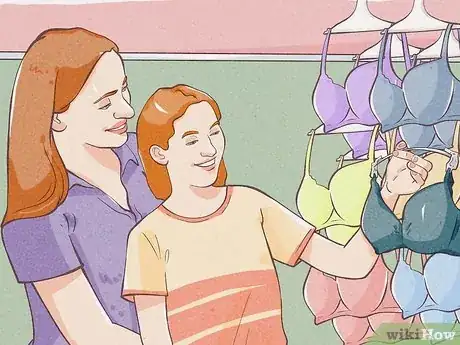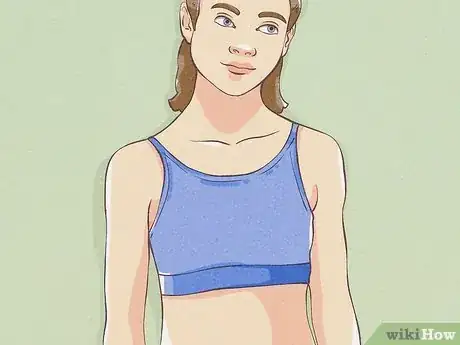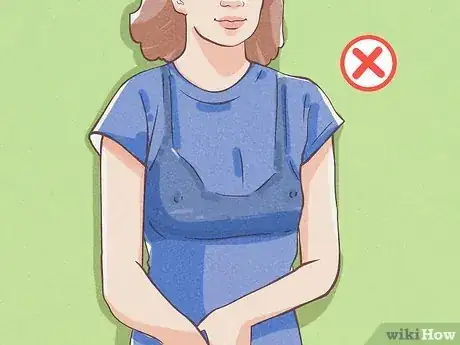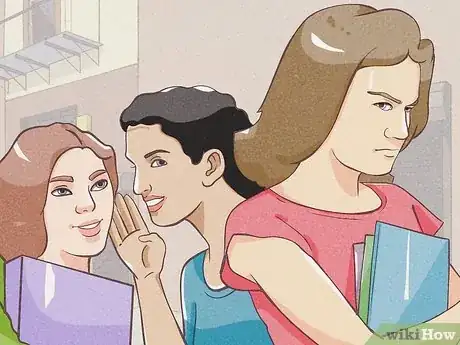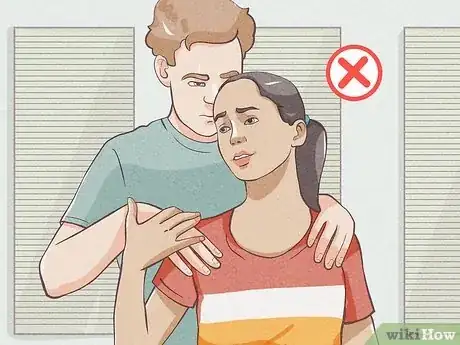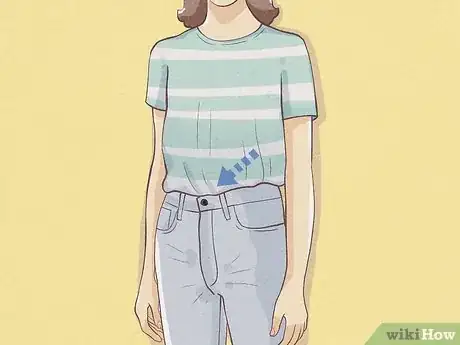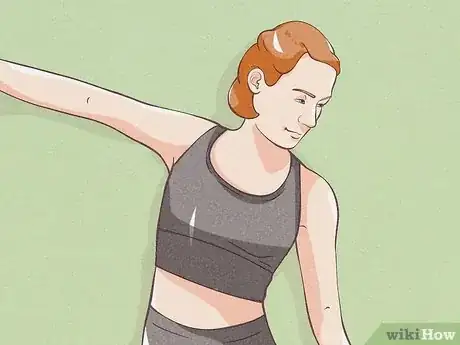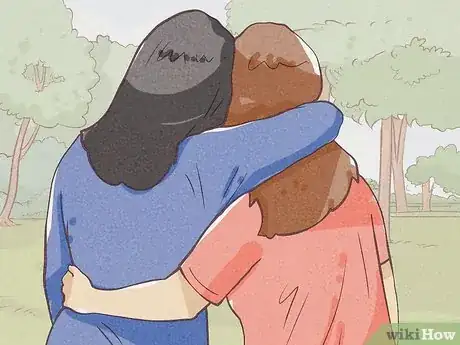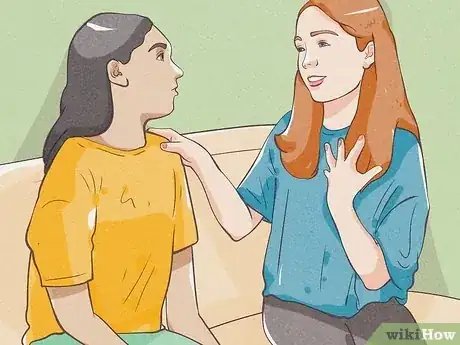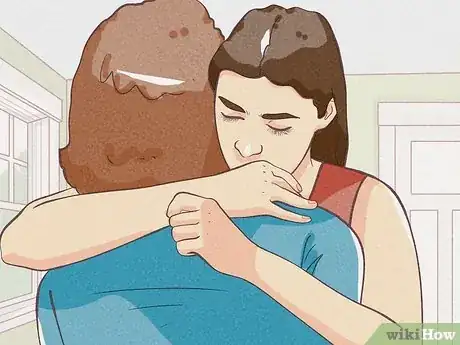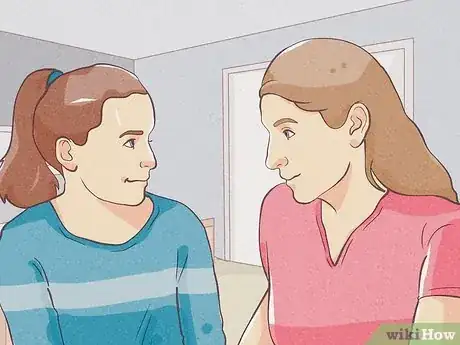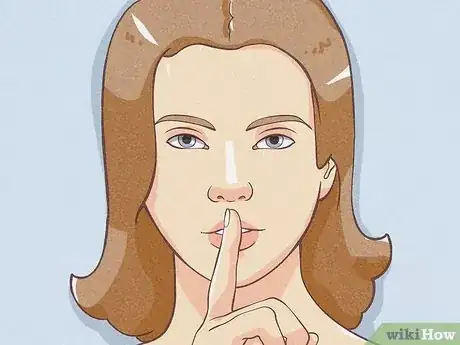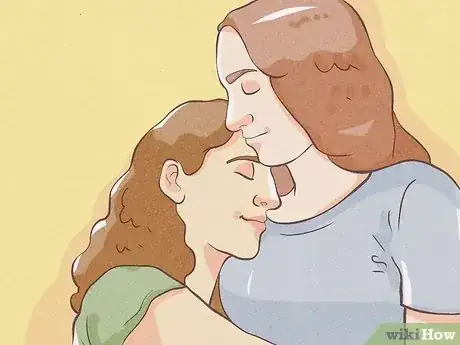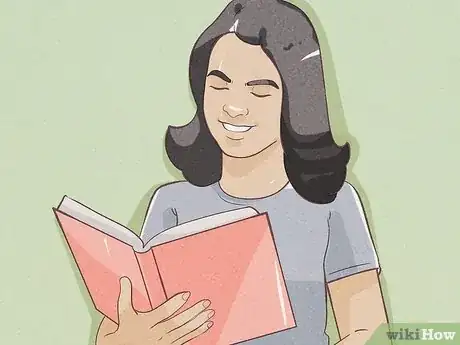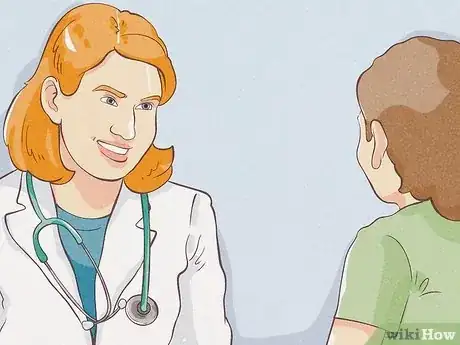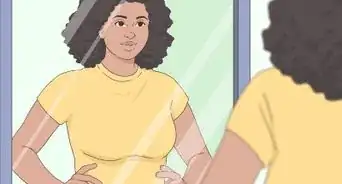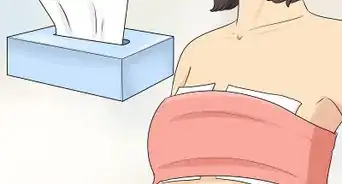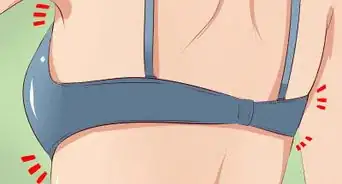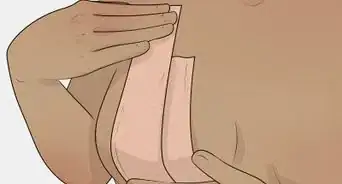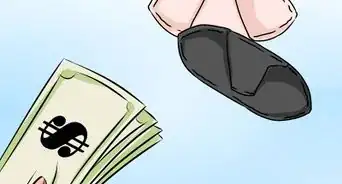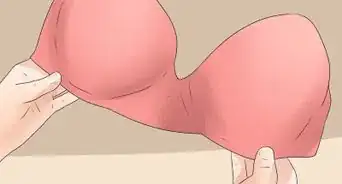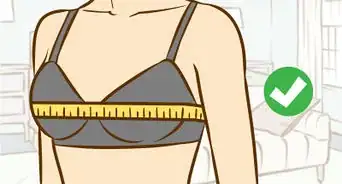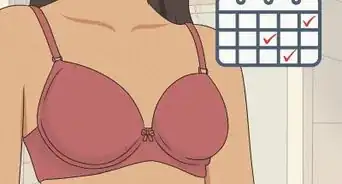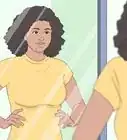wikiHow is a “wiki,” similar to Wikipedia, which means that many of our articles are co-written by multiple authors. To create this article, 31 people, some anonymous, worked to edit and improve it over time.
There are 7 references cited in this article, which can be found at the bottom of the page.
This article has been viewed 69,790 times.
Learn more...
Your friends are all flat chested but you're taking puberty by leaps and bounds. If you need to wear a bra at an early age, you don’t need to feel embarrassed or self-conscious. People develop at different rates and eventually everyone will catch up to you. This is all a natural part of growing up, but you don’t have to do it alone. Confide in your mom or aunt, enlist the support of your friends, and learn about what’s happening with your body.
Steps
Wearing the Right Bras
-
1Measure your chest. Wearing the right size of bra will go a long way to making you comfortable about the prospect of wearing one. Grab a measuring tape and measure yourself:
- Wrap the measuring tape around your chest against your ribs. Don’t pull it tight but it should rest snugly without slipping down.
- Write down this measurement in inches. Round up to the nearest inch. Add 5 to this number. This will be your chest or band size (size 32, 34, 36, etc.).
-
2Measure your breast size. Wrap the measuring tape around your breasts at the fullest part. Again, don’t pull the tape tight. Rather, it should rest snugly without slipping down.
- Write down this measurement in inches. Round up to the nearest inch. This will be the number you’ll use to calculate your cup size (AA, A, B, C, D, etc.) in the next step.
Advertisement -
3Calculate your cup size. Proper cup sizing is important so that you don’t wear something too small where your breasts don’t fit and spill out the sides. You also don’t want to wear something too big, because the bra can sit uncomfortably. To calculate cup size:
- AA: if the band size and cup measurement is the same, you are an AA cup size.
- A: less than 1” difference between band size and cup measurement.
- B: 1” – 2.5” difference between band size and cup measurement.
- C: 2.5” – 3.5” difference between band size and cup measurement.
- D: 3.5” – 4.5” difference between band size and cup measurement.
- DD (E): 4.5” – 6” difference between band size and cup measurement.
- You will grow out of your first bras. Every six months, measure yourself again to make sure you are wearing the right size.
-
4Bring a trusted adult friend. Go bra shopping with an adult that you trust, such as your mom or aunt. They can give you honest feedback about how the bra looks on you, and they may be able to buy you a few bras.
-
5Try out a few different types of bras. Bras can feel very different when you try them on and when you wear them all day. Try on a few different types, such as a sports bra, a cami, and a regular bra with cups to see which will be most comfortable. Buy a couple of different options and test them out when you’re at home. Which feel most comfortable to you?
- Try a sports bra, especially if you have smaller breasts. Sports bras do not usually have separate cups, and they are usually more comfortable than regular bras.
- Try an underwire bra if you have larger breasts. This type of bra can provide more adequate support.
- Try a tank top with a built-in bra. Ease into wearing a bra by choosing a tank top that has a built-in bra. You will look like you’re wearing a tank top only. Layer another shirt over the tank top.
- You probably don’t need to bother with a push-up or padded bra. These will usually make your breasts look bigger and can draw unwanted attention to yourself. Padded bras can add a bit of extra shape, however.
-
6Wear a bra that doesn’t show through your clothes. Don’t draw unnecessary attention to yourself with a bra that can be seen through your clothes. Skip the dark-colored bra when you’re wearing a light-colored shirt. Instead, go with something neutral-colored.
- Wear a bra made of fabric that isn’t too thin. Otherwise, your nipples might show through.
- Try on your shirt over the bra to see how it looks. You might have a decoration on the bra that could stick out under your shirt and be noticeable.[1]
Avoiding Teasing or Embarrassment
-
1Ignore teasing. It can be agonizing if someone is teasing you, especially if it’s in front of everyone. Ignore it as best you can. Sometimes, people tease because they are curious, or they don’t understand what is happening, or even that they like you.
- You might even try to come up with a snappy comeback to show how mature you are and how immature they are.
- If teasing continues more than a day or two, talk with your teacher or your trusted adult. You shouldn’t have to feel like you are a target just because your body is developing.
- Be calm when you talk to them. If you are defensive and angry, they may not take you as seriously. If you are calm, you can convey your feelings better and more seriously.
-
2Make others stop snapping your bra. One of the worst – and most common – things that other kids do is snap someone’s bra straps. Boys especially might be curious about bras and they want to find a way to get your attention. But snapping your bra strap is annoying and can even hurt.
- Tell them to stop touching your clothes. Explain that you don’t like it and it’s not welcome. If they don’t stop, tell a teacher or your trusted adult.
- If anyone is grabbing your breasts, tell them to stop and tell your teacher or trusted adult immediately.
- If you feel threatened or unable to make the behavior stop, you may be experiencing sexual harassment, which is someone’s behavior that makes you feel unsafe. Read more about sexual harassment in the wikiHow article, “How to Deal With Sexual Harassment in School.”
-
3Go for privacy if you need to change your clothes. While you don’t need to feel embarrassed about your body and bra, you might feel more at ease if you change your clothes in private. When spending the night at a friend’s house, you can change your clothes in the bathroom.
- If you need to change your clothes for gym class, you can either do it in a bathroom stall, or you can try to get changed as discreetly as possible. Choose a locker near one of your friends. They will be more likely to support you, instead of teasing you. Turn your back to the rest of the girls in the changing room. Read more tips at the wikiHow article, “How to Change In a School Locker Room.”
-
4Tuck in your shirt on the playground. If you are swinging upside down on the monkey bars, your shirt might fly up and reveal your bra. Tuck in your shirt to avoid an embarrassing or revealing situation.
-
5Wear a sports bra for PE. When you’re in PE class, you might need extra support for your breasts. Otherwise, you might bounce up and down uncomfortably when you’re running or jumping. Wear a well-fitting sports bra for exercise and you will be more comfortable.
Handling Your Friends
-
1Confide in your best friend. Your best friend isn’t called that for nothing. Your best friend wants to help you feel good about yourself. If something is bothering you, talk with your best friend about your concerns. They can come to your rescue if someone is teasing you.
-
2Be a source of information for your friends. Even though you might feel self-conscious about wearing a bra when none of your friends wears one, they might be curious about what will happen to their bodies. You can be a source of information for your friends by telling them how to get a bra, what kinds of bras there are, and what it feels like to reach puberty.
-
3Support others. If there are any other kids who are also wearing bras at a young age, support them. Defend them if anyone is teasing them. Help them figure out how to talk with their mom or aunt. This can even start a new friendship for you.
Learning About Your Body’s Development
-
1Talk with an adult you trust. Find an adult that you trust, such as your mom, aunt or older sister, about your concerns. Your body is probably undergoing other changes, too, that you might want to talk about. It may help to talk with a person who has experience wearing a bra. Start off by saying that you want to talk, and be positive with the conversation. Assure them that nothing is wrong, but that you have some questions about your body and about growing up.[2]
- You can start things off with a question like, “When did you first wear a bra?”
-
2Ask to keep the conversation private. When talking with this person, ask them to keep the conversation private. Some parents or other adults may be excited for you to start puberty and to develop into an adult. But this can be potentially embarrassing for you. Ask your trusted adult to not make announcements to other people about how you’re growing up.
-
3Ask for help with siblings. If you have a pesky little brother or sister, they might not realize that there should be boundaries. If you feel embarrassed about wearing a bra, ask your trusted adult to make sure your siblings don’t tease you. If you don’t feel comfortable talking to your parents about this, your trusted adult can say something for you.
-
4Read a book about your development. Check out a book from the library about female puberty and find out more about what’s happening with your body. You’ll find out that it’s very natural to grow breasts, even if it’s happening a little earlier for you than for your friends.
- If you don’t want to check out the book from the library, ask your mom if she will buy one for you.
- There are also some great websites about female puberty, which can answer a lot of questions that you might have about your body. These include KidsHealth.org,[3] BeingGirl.com, and GirlsHealth.gov.[4]
-
5Learn more about body image and the media. Body image is how you see yourself and the feelings you have about your body and self.[5] Images you see in advertising, movies, magazines, and on TV can be distorted, leading you to think about what’s a normal body. But the truth is that everyone is shaped differently and there is no single perfect body.
-
6Visit your pediatrician. You might find it helpful to talk with your doctor about your body. You can ask questions in private and they will give you honest answers without judging you or making you feel self-conscious.
Community Q&A
-
QuestionI am only 10 years old and I have to wear a bra. Is this normal at my age?
 Community AnswerYes, it's completely normal. It's common for girls to start wearing bras anywhere between ages 9-13.
Community AnswerYes, it's completely normal. It's common for girls to start wearing bras anywhere between ages 9-13. -
QuestionHow big do my breasts need to be to wear a bra?
 Community AnswerThere's really no particular size you need to reach before buying a bra. Generally, if your breasts are getting bigger, they're sore, and/or your nipples are poking through your shirt, it's time to get a bra.
Community AnswerThere's really no particular size you need to reach before buying a bra. Generally, if your breasts are getting bigger, they're sore, and/or your nipples are poking through your shirt, it's time to get a bra. -
QuestionWhat do I do if my friends are wearing bras even though they don't need them yet?
 Community AnswerYou don't have to do anything. If your friends are happier wearing a bra, that's fine. It doesn't mean you have to do the same.
Community AnswerYou don't have to do anything. If your friends are happier wearing a bra, that's fine. It doesn't mean you have to do the same.
References
- ↑ http://www.kidshealth.org/en/kids/breasts-bras.html#catbreasts
- ↑ http://teenspeak.org/2014/12/30/talking-to-your-parents/
- ↑ http://kidshealth.org/
- ↑ http://www.girlshealth.gov/body/puberty/
- ↑ https://www.nationaleatingdisorders.org/body-image-0
- ↑ http://mediasmarts.ca/digital-media-literacy/media-issues/body-image
- ↑ http://kidshealth.org/teen/your_mind/body_image/body_image.html
